 "ttyymmnn" (ttyymmnn)
"ttyymmnn" (ttyymmnn)
07/27/2018 at 12:35 • Filed to: wingspan, Planelopnik, TDIAH
 4
4
 12
12
 "ttyymmnn" (ttyymmnn)
"ttyymmnn" (ttyymmnn)
07/27/2018 at 12:35 • Filed to: wingspan, Planelopnik, TDIAH |  4 4
|  12 12 |
!!! UNKNOWN CONTENT TYPE !!!
Welcome to
This Date in Aviation History
, getting of you caught up on milestones, important historical events and people in aviation from July 25 through July 27.
!!! UNKNOWN CONTENT TYPE !!!
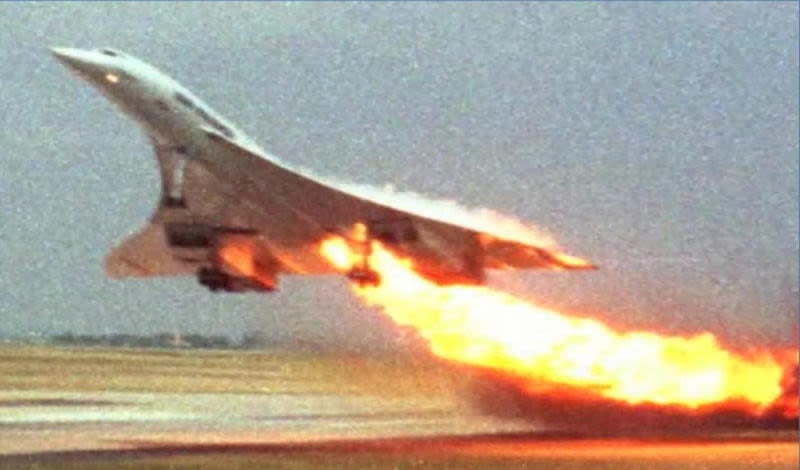
(Toshihiko Sato)
July 25, 2000 – The crash of Air France Flight 4590. Chuck Yeager and the !!!error: Indecipherable SUB-paragraph formatting!!! broke the sound barrier for the first time in 1947 and, for the next twenty years, supersonic flight was solely the purview of the military. But within a few short years, commercial aircraft designers began to imagine what a supersonic airliner might look like. In the 1950s, both England and France began development of their own SST, and the two countries eventually signed a treaty in 1962 to begin working together, an agreement which culminated in the !!!error: Indecipherable SUB-paragraph formatting!!! and gave the revolutionary airliner its name. Ultimately, 20 Concordes were built, six of which were prototypes and used for development and testing. Of the remaining 14, Air France and British Airways each received seven.
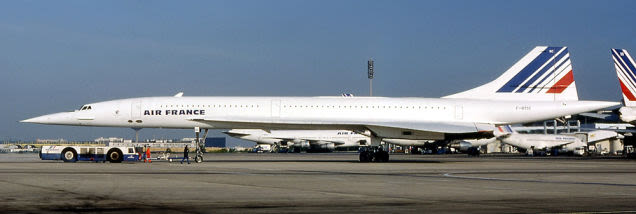 !!!CAPTION ERROR: MAY BE MULTI-LINE OR CONTAIN LINK!!!
!!!CAPTION ERROR: MAY BE MULTI-LINE OR CONTAIN LINK!!!
Following its introduction in 1976, Concorde flew regular routes from London and Paris to New York City, Washington, DC and Barbados. More cities followed as Concorde expanded it routes. The SST’s four !!!error: Indecipherable SUB-paragraph formatting!!! afterburning turbojets provided a maximum cruising speed of Mach 2.04, and cut the flying time between transatlantic destinations in half when compared to traditional airliners. And, for most of its operational history, Concorde had a stellar safety record. Only twice had there been incidents that could have led to a crash. In 1989, a British Airways Concorde suffered a structural failure of the vertical stabilizer, followed by a similar failure on another British Airways Concorde in 1992. On both occasions, the airliner landed safely. Only one Concorde has ever suffered a fatal crash, but that single accident ultimately helped bring an end to all Concorde flights.
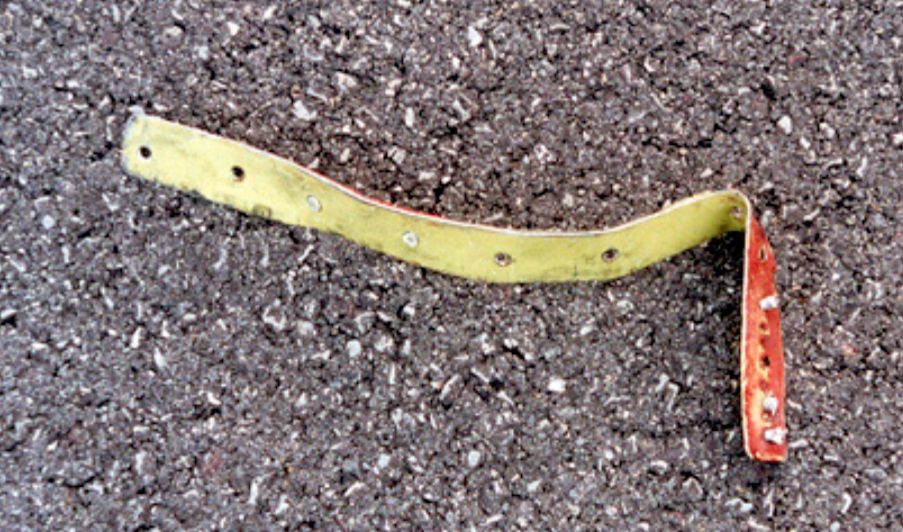 !!!CAPTION ERROR: MAY BE MULTI-LINE OR CONTAIN LINK!!!
!!!CAPTION ERROR: MAY BE MULTI-LINE OR CONTAIN LINK!!!
On July 25, 2000, Air France Flight 4590 (F-BTSC), a charter flight from Charles de Gaulle Airport in Paris, began its takeoff roll and was bound New York’s John F. Kennedy Airport. While at full power and committed to taking off, the airliner suffered a catastrophic fire and crashed into a hotel near the airport, killing all 109 passengers and crew on board plus four people on the ground. The !!!error: Indecipherable SUB-paragraph formatting!!! (BEA) carried out the official investigation and !!!error: Indecipherable SUB-paragraph formatting!!! that the crash was caused by a series of events that began when a strip of titanium alloy fell off of a Continental Airlines !!!error: Indecipherable SUB-paragraph formatting!!! which had departed ahead of Flight 4590. The debris punctured the tire on the departing SST, and a large chunk of the damaged tire struck the wing and ruptured the fuel tank. This caused fuel to pour from the tank which was then ignited by the engine and led to the loss of the two port engines. The cockpit crew was able to restore power to one of the failed engines, but the extra drag from the landing gear, which could not be retracted, in concert with the asymmetric thrust caused by the loss of engine power on one side, caused the pilots to lose control of the supersonic airliner and it crashed to the Hôtelissimo Les Relais Bleus Hotel near the airport
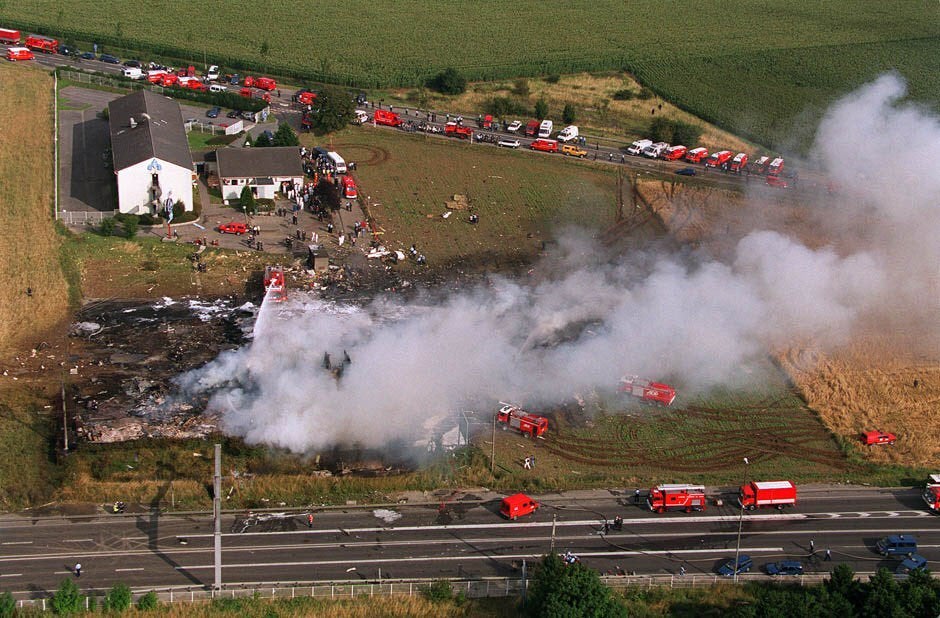
The crash site of Air France 4590. Four people on the ground were killed, along with the all 109 passengers and crew on the Concorde. (Author unknown)
Continental Airlines, along with one of its mechanics, was initially found guilty of involuntary manslaughter for the metal debris on the runway, but that ruling was overturned. During the trial, however, witnesses questioned the official BEA explanation, saying that a wheel spacer had not been installed on the left landing gear, and that the plane actually caught fire some 1,000 feet prior to passing the metal dropped by the Continental DC-10. The official explanation remained unchanged, though. As a result of the crash, all Concordes were grounded until safety upgrades could be made. Electronic flight controls were made more secure, the fuel tanks were lined with Kevlar to help shield them from debris, and special burst-resistant tires were fitted to the remaining airliners. Concorde finally flights resumed after a 14-month hiatus, but low passenger numbers and a drop in air travel following the terrorist attacks of September 11, 2001, as well as rising maintenance costs, led to the Concorde’s complete retirement in November 2003.
!!! UNKNOWN CONTENT TYPE !!!
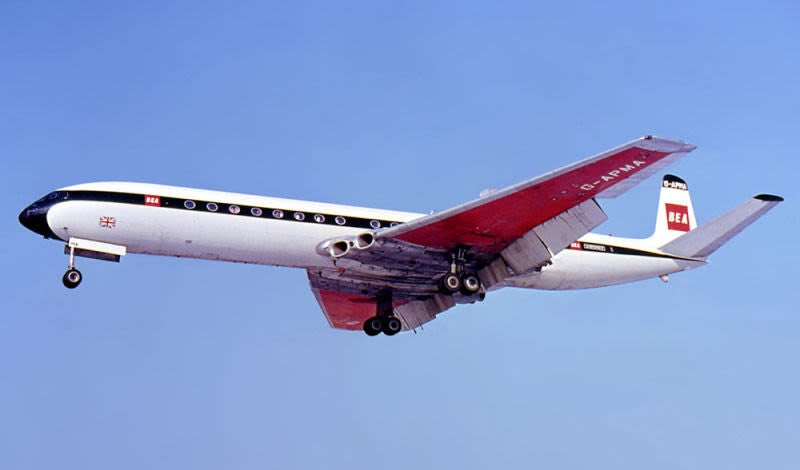 !!!CAPTION ERROR: MAY BE MULTI-LINE OR CONTAIN LINK!!!
!!!CAPTION ERROR: MAY BE MULTI-LINE OR CONTAIN LINK!!!
July 27, 1949 – The first flight of the de Havilland Comet. Though we tend to think of the jet engine as a product of WWII, work had begun on the development of the turbojet engine as early as 1921. The first patent for an axial flow turbojet was granted to Frenchman !!!error: Indecipherable SUB-paragraph formatting!!! , though the engine was never built. Work progressed through the 1930s and 1940s, and both Britain and Germany fielded jet-powered fighters by the end of the war. The next logical step was to take the power of the jet engine and apply it to a large passenger airliner.
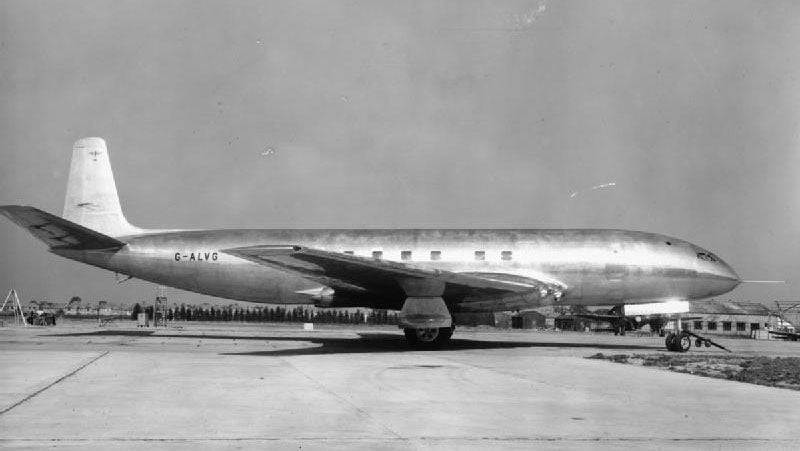
The Comet 1 prototype at Hatfield, Hertfordshire in 1949. (British Government)
The Comet 1 prototype at Hatfield, Hertfordshire in 1949. (British Government)During the war, the British and Americans decided to split up the development of large, multi-engine aircraft, with the Americans assuming responsibility for transport aircraft, while the British focused on production of heavy bombers. However, that arrangement would leave the British in the unenviable position of having very little infrastructure or expertise for the production of transport aircraft when the war ended. To address shortcoming, the British formed the !!!error: Indecipherable SUB-paragraph formatting!!! in 1942 under the direction of !!!error: Indecipherable SUB-paragraph formatting!!! which was tasked with the development of large, pressurized aircraft that could carry mail and passengers across the Atlantic Ocean. The committee began meeting in early 1943 and, over the next two years, they found that the requirements of the civilian aviation industry called for five different types of aircraft. One of the aircraft, designated the Type IV, would be a 100-seat, jet-powered, pressurized transatlantic mailplane that could carry one !!!error: Indecipherable SUB-paragraph formatting!!! of cargo at a cruising speed of 400 mph nonstop across the Atlantic.
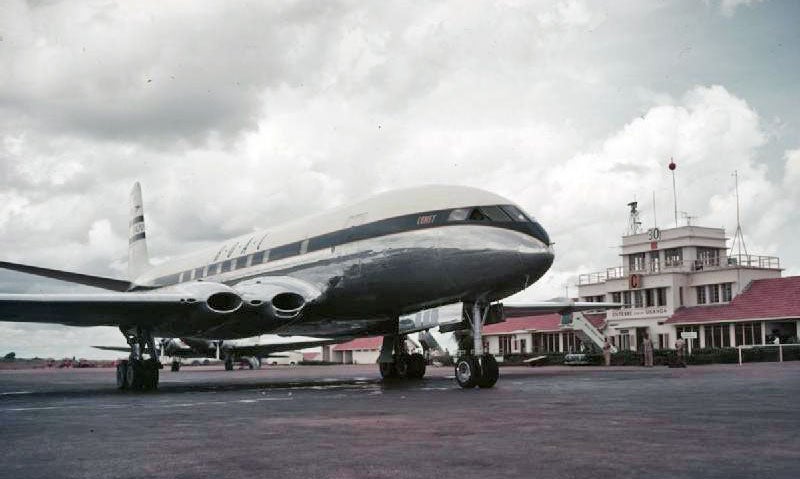
A Comet 1 of BOAC at Entebbe, Uganda in 1952. (UK Ministry of Information)
A proposal for such an aircraft was put forward by !!!error: Indecipherable SUB-paragraph formatting!!! , who headed his own aircraft company and had influential government ties. If successful, the new airliner would fill the need for the Type IV aircraft, as well as Type III, a short-range airliner capable of serving multi-hop routes around the British Empire. A contract was awarded to develop the de Havilland Type 106, which later became known as the DH 106, and de Havilland undertook the design of both the airframe and the engines. While initial studies into the design of the Comet included proposals for a radical tailless design, de Havilland eventually settled on a traditional configuration with a straight wing that had a leading edge swept at 20 degrees and a straight tailplane. The engines were housed in the wing roots, and the groundbreaking airliner featured large, square windows for the passengers. The prototype was powered by four !!!error: Indecipherable SUB-paragraph formatting!!! turbojet engines, but those were replaced by more powerful !!!error: Indecipherable SUB-paragraph formatting!!! axial flow jet engines in production models.
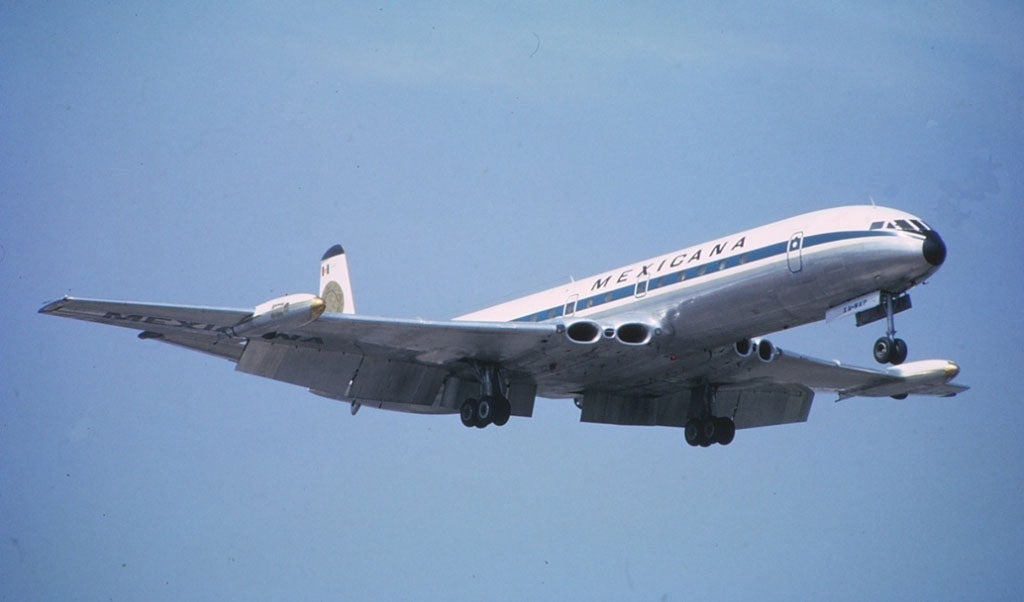 !!!CAPTION ERROR: MAY BE MULTI-LINE OR CONTAIN LINK!!!
!!!CAPTION ERROR: MAY BE MULTI-LINE OR CONTAIN LINK!!!
After rigorous testing, the first Comet prototype took its maiden flight on July 27, 1949, and the Comet was introduced to the world at the Farnborough Airshow later that year. It entered service with !!!error: Indecipherable SUB-paragraph formatting!!! (BOAC) on May 2, 1952 and was an immediate success, attracting high-profile passengers including the !!!error: Indecipherable SUB-paragraph formatting!!! . However, structural weaknesses around the large windows soon caused a number of fatal in-flight explosive decompressions, and the Comet was pulled from service in 1954 to investigate the cause of the hull losses. The failures were traced to fatigue cracks around the large windows that arose from repeated pressurization and depressurization of the fuselage, so new rounded windows were introduced, along with a strengthened hull. Comets returned to the skies in 1958 and, though the accidents hurt sales, the airliner went on to enjoy a long career, even after it was surpassed by more modern airliners like the !!!error: Indecipherable SUB-paragraph formatting!!! . Continued development of the Comet led to the creation of variants that stretched the airliner and added more seats and more fuel for increased range. And, when it looked like the Comet’s flying days were over, it was further developed into the !!!error: Indecipherable SUB-paragraph formatting!!! maritime patrol and surveillance aircraft. Including the prototypes, a total of 114 Comets were produced, and the last was retired in 1997.
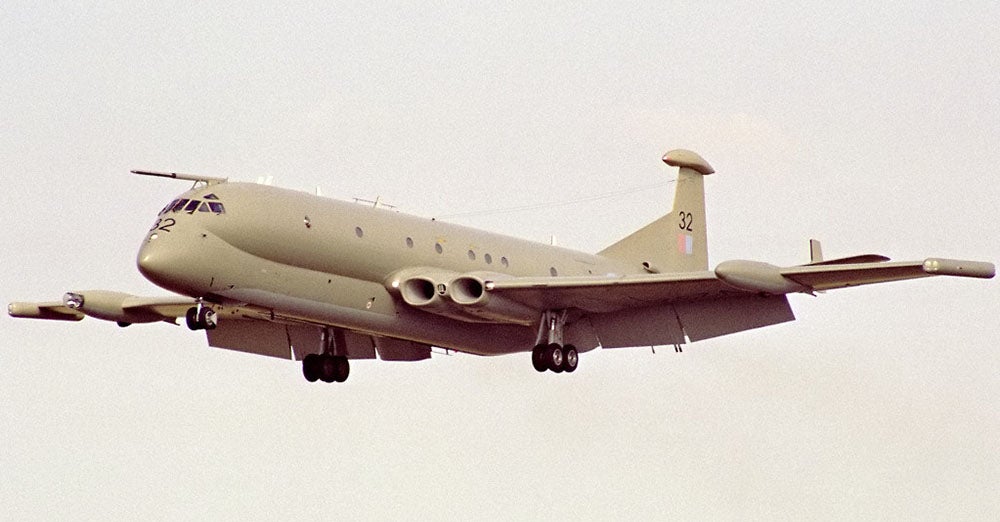 !!!CAPTION ERROR: MAY BE MULTI-LINE OR CONTAIN LINK!!!
!!!CAPTION ERROR: MAY BE MULTI-LINE OR CONTAIN LINK!!!
!!! UNKNOWN CONTENT TYPE !!!
Short Takeoff
!!! UNKNOWN CONTENT TYPE !!!
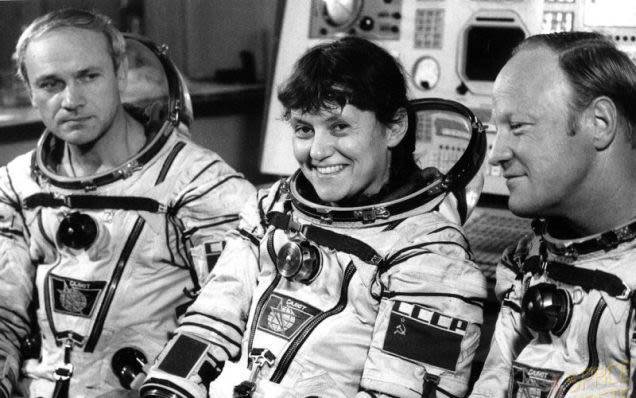
(Author unknown)
July 25, 1984 – Cosmonaut Svetlana Savitskaya becomes the first woman to perform a spacewalk (EVA). Savitskaya began her career as a pilot and set 18 international world records flying MiG fighters and another three records in team parachute jumping before beginning her training as a cosmonaut in 1980. She went to space for the first time in 1982 as a crew member of the !!!error: Indecipherable SUB-paragraph formatting!!! mission, a flight which made Savitskaya the second woman in space. On her second trip into Earth orbit, she performed an !!!error: Indecipherable SUB-paragraph formatting!!! outside of the !!!error: Indecipherable SUB-paragraph formatting!!! space station and spent over three hours in space tethered to the station. Savitskaya was twice awarded the title !!!error: Indecipherable SUB-paragraph formatting!!! , her nation’s highest honor. She retired from the Russian Air Force in 1993 with the rank of major.
!!! UNKNOWN CONTENT TYPE !!!
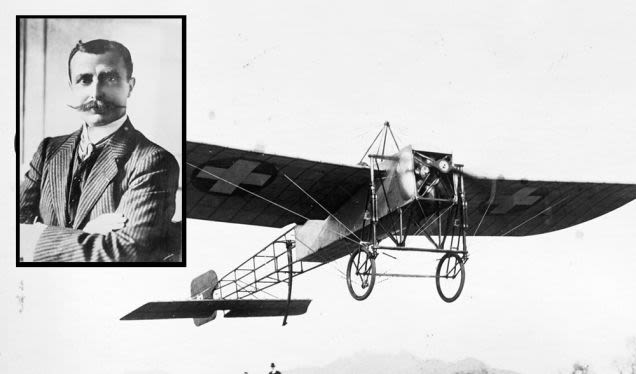
(US Library of Congress)
July 25, 1909 – French pilot Louis Blériot becomes the first person to fly across the English Channel. Blériot was one of the pioneering French aviators in the early days of powered flight, set numerous records for flight, and formed his own airplane manufacturing company. In the early days of powered flight, the the English Channel was considered one of the great obstacles to be conquered, and Blériot achieved his greatest fame when he took off from France and flew his !!!error: Indecipherable SUB-paragraph formatting!!! monoplane, powered by a 25-horsepower, 3-cylinder Anzani motor, across the Channel. After 36 minutes of flight, Blériot landed hard in England and damaged his aircraft. Fortunately, Blériot was unhurt, and he claimed a £1,000 prize for being the first to make the crossing.
!!! UNKNOWN CONTENT TYPE !!!
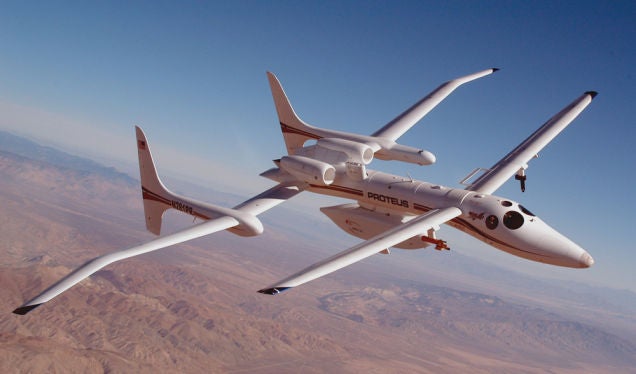
(US Department of Energy)
July 26, 1998 – The first flight of the Scaled Composites Proteus, a tandem-wing high-altitude research aircraft developed by aviation pioneer !!!error: Indecipherable SUB-paragraph formatting!!! to investigate the use of aircraft as telecommunications relays. The composite aircraft has a 77-foot wingspan that can be increased to 92 feet for high-altitude flight, and holds world records for altitude, setting a record of 63,245 feet in October 2000. Due to the aerodynamic efficiency of the design, Proteus is capable of loitering over a point on the Earth at 60,000 feet for more than 18 hours. One aircraft was built, and it has carried out numerous experiments in coordination with NASA and the !!!error: Indecipherable SUB-paragraph formatting!!! (DARPA). Proteus remains in service and currently belongs to Northrop Grumman.
!!! UNKNOWN CONTENT TYPE !!!
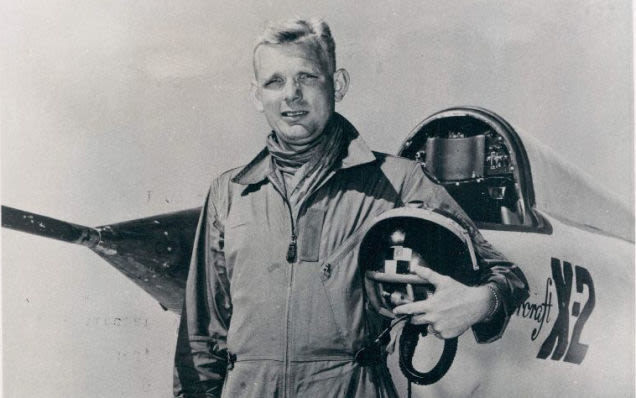
(US Air Force)
July 26, 1958 – The death of Iven Carl Kincheloe, Jr, a US Air Force test pilot, aeronautical engineer, and double ace in the Korean War. Kincheloe was born in Detroit, Michigan in 1928 and, after a military career in which he received the !!!error: Indecipherable SUB-paragraph formatting!!! , he became a test pilot for the US Air Force’s !!!error: Indecipherable SUB-paragraph formatting!!! of fighter aircraft and was awarded the !!!error: Indecipherable SUB-paragraph formatting!!! three times. While piloting a !!!error: Indecipherable SUB-paragraph formatting!!! , Kincheloe became “America’s No. 1 Spaceman” when he exceeded 100,000 feet of altitude and was credited as the first man to enter outer space. Kincheloe was killed when he failed to eject from his crippled !!!error: Indecipherable SUB-paragraph formatting!!! during a flight over Edwards AFB in California.
!!! UNKNOWN CONTENT TYPE !!!
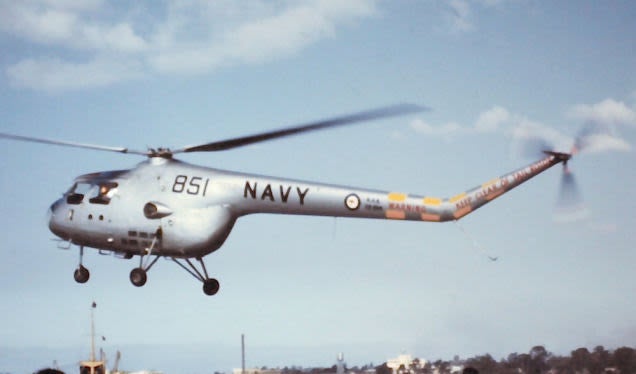 !!!CAPTION ERROR: MAY BE MULTI-LINE OR CONTAIN LINK!!!
!!!CAPTION ERROR: MAY BE MULTI-LINE OR CONTAIN LINK!!!
July 27, 1947 – The first flight of the Bristol Sycamore, the first domestically designed and built helicopter to serve with the Royal Air Force. Bristol began working on helicopters as early as 1944, and development of the Sycamore took over two years. The prototype was powered by a !!!error: Indecipherable SUB-paragraph formatting!!! 9-cylinder radial engine, though production models were fitted with an !!!error: Indecipherable SUB-paragraph formatting!!! radial engine which provided a top speed of 132 mph. The Sycamore entered service in April 1953 and served during the !!!error: Indecipherable SUB-paragraph formatting!!! , and was also flown by Germany, Belgium and Australia. A total of 180 were built from 1947-1955, and the type was retired in 1972.
!!! UNKNOWN CONTENT TYPE !!!
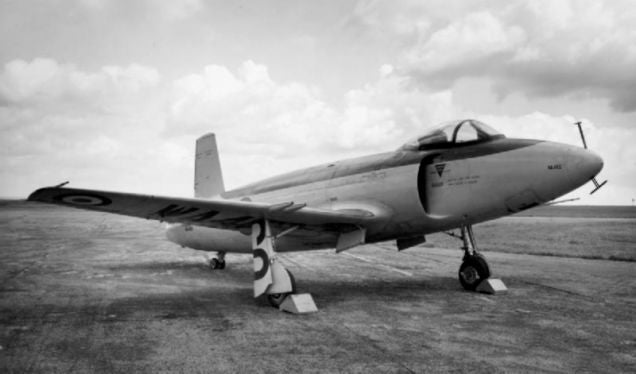
(UK Government)
July 27, 1946 – The first flight of the Supermarine Attacker,
a fighter developed for the Royal Navy’s Fleet Air Arm (FAA) and the first jet fighter to enter operational service with the FAA. The Attacker has its roots in the
!!!error: Indecipherable SUB-paragraph formatting!!!
, a piston-powered fighter designed to replace the
!!!error: Indecipherable SUB-paragraph formatting!!!
. The Attacker used the same straight,
!!!error: Indecipherable SUB-paragraph formatting!!!
wings of the Spiteful and was powered by a single
!!!error: Indecipherable SUB-paragraph formatting!!!
turbojet which gave it a top speed of 590 mph. Since the wings came from an existing fighter, the Attacker had a tailwheel landing gear, an unusual arrangement for a jet fighter. The Attacker entered service with the FAA in 1951, but developments in jet fighter design quickly rendered it obsolete, and it was withdrawn from service in 1954 after the production of 182 aircraft.
!!! UNKNOWN CONTENT TYPE !!!

(Deutsches Bundesarchiv)
July 27, 1937 – The first flight of the Focke-Wulf Fw 200 Condor,
a large four-engine aircraft originally developed by
!!!error: Indecipherable SUB-paragraph formatting!!!
as a long-range transatlantic airliner. Focke-Wulf’s chief designer
!!!error: Indecipherable SUB-paragraph formatting!!!
developed the Condor to cruise at nearly 10,000 feet, the limit for an unpressurized airliner. The Condor enjoyed a brief career as an airliner with Deutsche Lufthansa, where it set a record for flying from Berlin to New York City in just under 25 hours. With the outbreak of WWII, Focke-Wulf added a gondola and bomb bay to turn the Condor into a long-range maritime patrol bomber. Later, the Condor was used exclusively by the Luftwaffe as a troop and VIP transport. A total of 276 were produced from 1937-1944.
!!! UNKNOWN CONTENT TYPE !!!
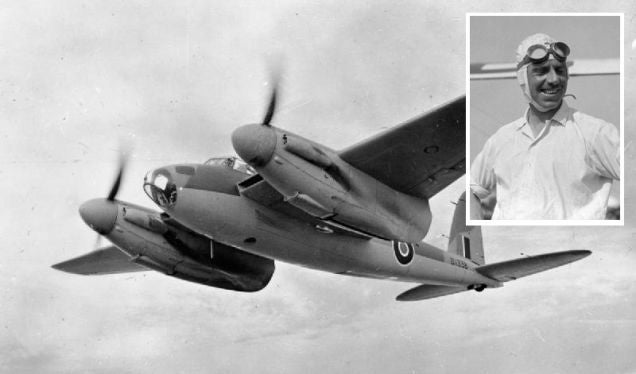
(Australian Government; UK Government)
July 27, 1882 – The birth of Sir Geoffrey de Havilland,
a British aviation pioneer and aeronautical engineer responsible for some of the preeminent military aircraft of WWII. De Havilland built his first aircraft in 1910, and formed the
!!!error: Indecipherable SUB-paragraph formatting!!!
in 192o. His company produced the
!!!error: Indecipherable SUB-paragraph formatting!!!
multi-role fighter/bomber during the war and, as part of the Brabazon Committee, de Havilland oversaw the production of the
!!!error: Indecipherable SUB-paragraph formatting!!!
, the world’s first jet-powered airliner. De Havilland remained in control of his company until it was bought by
!!!error: Indecipherable SUB-paragraph formatting!!!
in 1960, and he died in 1962 at the age of 82.
!!! UNKNOWN CONTENT TYPE !!!
Connecting Flights
!!! UNKNOWN CONTENT TYPE !!!
!!! UNKNOWN CONTENT TYPE !!!
!!! UNKNOWN CONTENT TYPE !!!
!!! UNKNOWN CONTENT TYPE !!!
!!! UNKNOWN CONTENT TYPE !!!
If you enjoy these Aviation History posts, please let me know in the comments. And if you missed any of the past articles, you can find them all at
!!!error: Indecipherable SUB-paragraph formatting!!!
. You can also find more stories about aviation, aviators and airplane oddities at
!!!error: Indecipherable SUB-paragraph formatting!!!
.
!!! UNKNOWN CONTENT TYPE !!!
 KingT- 60% of the time, it works every time
> ttyymmnn
KingT- 60% of the time, it works every time
> ttyymmnn
07/27/2018 at 12:42 |
|
Interesting fact- The Condor was called the “ scourge of the Atlantic ” by Winston Churchill for its deadly efficiency between 1940 and 1942.
http://ww2today.com/august-1940-condor-aircraft-join-the-battle-of-the-atlantic
 Highlander-Datsuns are Forever
> ttyymmnn
Highlander-Datsuns are Forever
> ttyymmnn
07/27/2018 at 13:25 |
|
https://www.quora.com/How-do-fighter-jet-pilots-pee-or-poop
some how your post turned me down this road....
 OPPOsaurus WRX
> ttyymmnn
OPPOsaurus WRX
> ttyymmnn
07/27/2018 at 13:47 |
|
alternate world: Concorde has airport chili and prove you should never have the airport chili
 ttyymmnn
> Highlander-Datsuns are Forever
ttyymmnn
> Highlander-Datsuns are Forever
07/27/2018 at 14:22 |
|
I can’t even imagine why.
 Highlander-Datsuns are Forever
> ttyymmnn
Highlander-Datsuns are Forever
> ttyymmnn
07/27/2018 at 14:30 |
|
How do you fly a plane for 18 hrs without going #1?
 You can tell a Finn but you can't tell him much
> Highlander-Datsuns are Forever
You can tell a Finn but you can't tell him much
> Highlander-Datsuns are Forever
07/27/2018 at 15:10 |
|
Can’t stop laughing at the mental image of the gymnastics required to pop a squat in a Tomcat cockpit.
 Highlander-Datsuns are Forever
> You can tell a Finn but you can't tell him much
Highlander-Datsuns are Forever
> You can tell a Finn but you can't tell him much
07/27/2018 at 15:28 |
|
This is one of the better threads I’ve ever read.
 WilliamsSW
> ttyymmnn
WilliamsSW
> ttyymmnn
07/27/2018 at 21:52 |
|
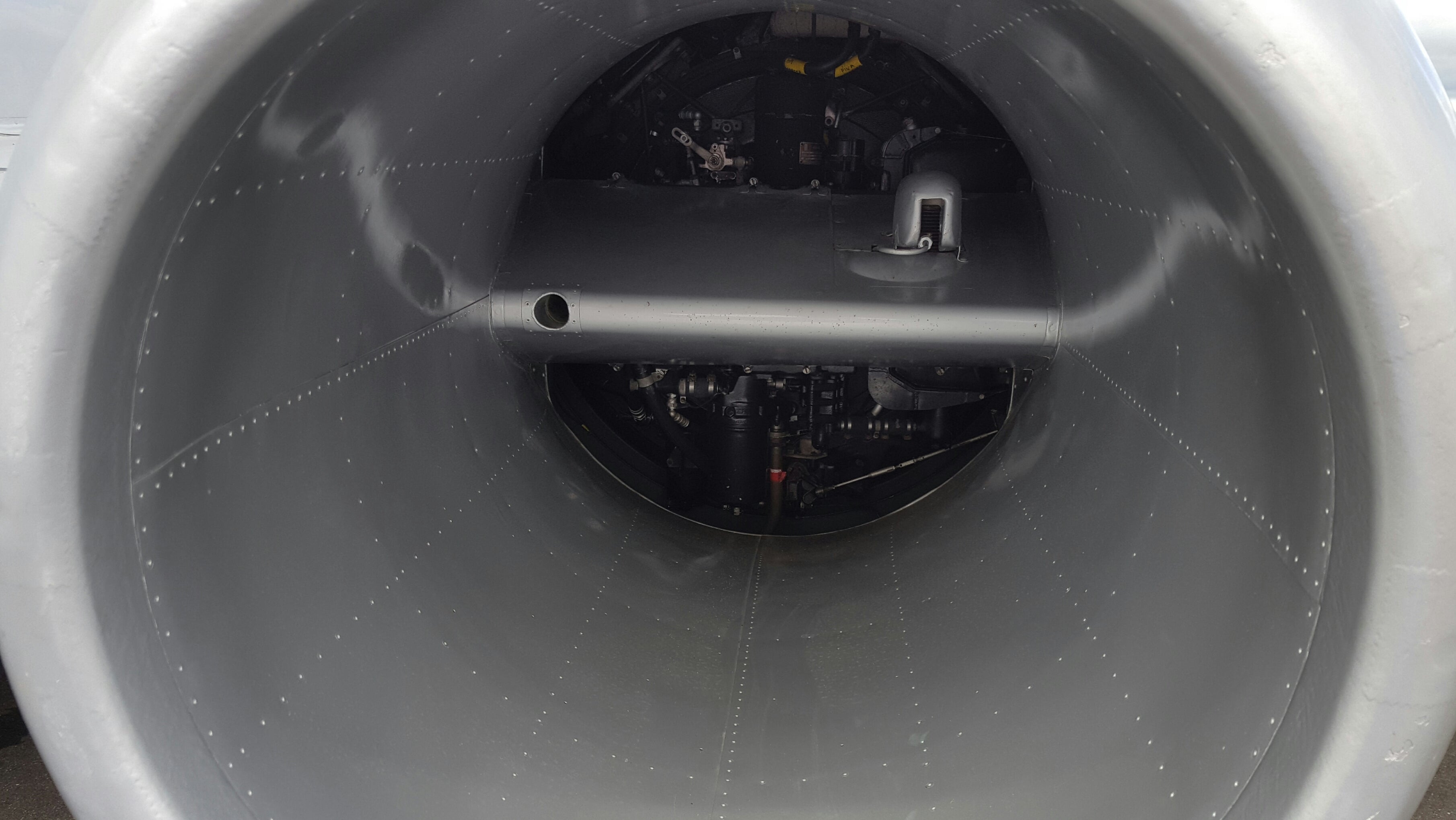
Check
out
the
intake
on
this
jet
engine
on
a
Gloster
Meteor.
Doesn’t look anything like what I’m used to.
 ttyymmnn
> WilliamsSW
ttyymmnn
> WilliamsSW
07/27/2018 at 21:56 |
|
Looks like the leading edge of the wing. No idea why they would do that.
 WilliamsSW
> ttyymmnn
WilliamsSW
> ttyymmnn
07/27/2018 at 22:47 |
|
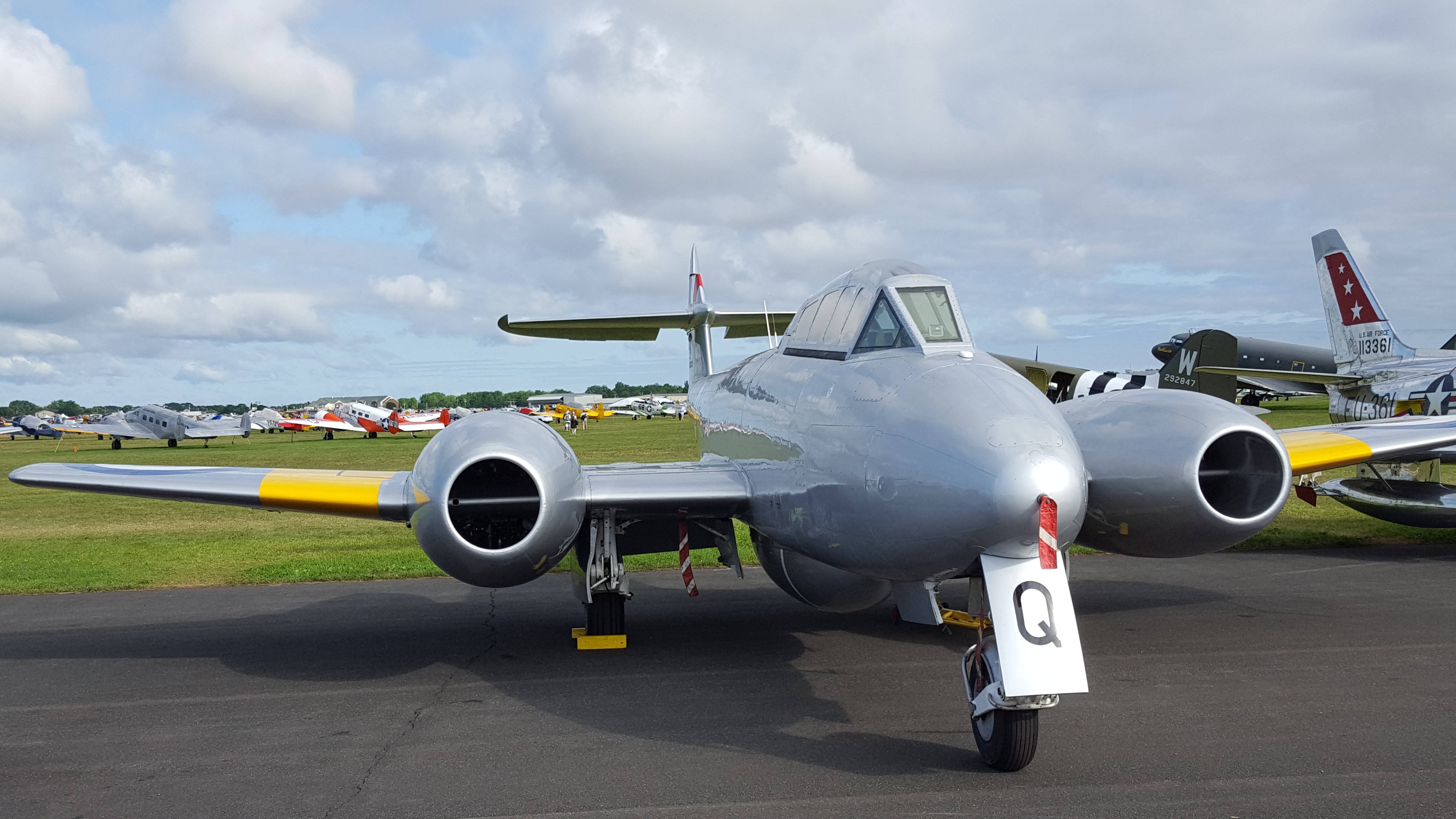
No clue. It’s not exactly the leading edge, but maybe it’s structural?
 ttyymmnn
> WilliamsSW
ttyymmnn
> WilliamsSW
07/27/2018 at 22:52 |
|
That was my next guess. Take a look at this.
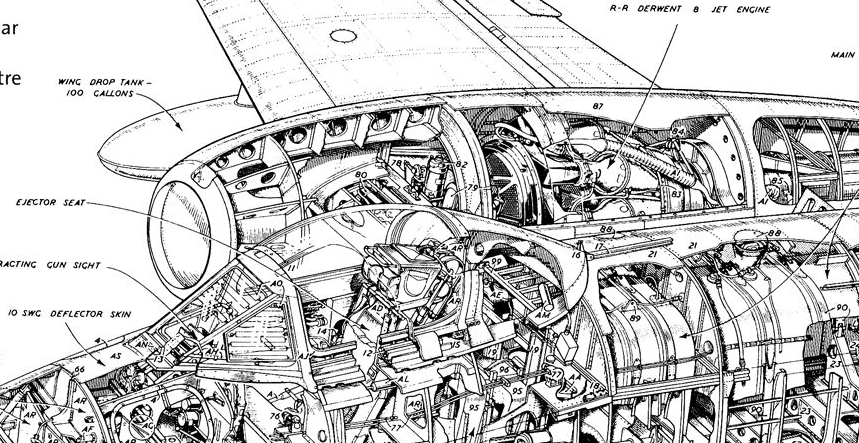
Full size here .
 WilliamsSW
> ttyymmnn
WilliamsSW
> ttyymmnn
07/27/2018 at 23:49 |
|
Yeah, based on that diagram and a look at the Derwent engine, I’d say that’s structural.